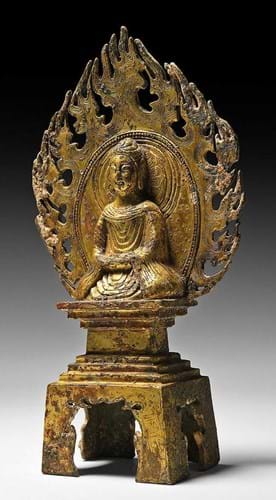Buddhism had first come to China via the Silk Road under the Han but it was during the 5th century that it flourished. In an effort to prove their legitimacy, the foreign Tuoba enthusiastically sponsored the construction of temples and the making of images.
Many of the most important Buddhist sites in China – the Yungang Grottoes, the Longmen Caves, the Shaolin Monastery and the Songyue Pagoda – were built under their direct patronage.
Bronze casting of Buddhist images also reached a new peak under the Northern Wei. Small portable figures such as that offered by TimeLine Auctions in Harwich, Essex on September 1, were made in production centres in Hebei and Shandong provinces.
Most are reminiscent of stone sculpture from the Gandhara and neighbouring Uddiyana regions – the ‘gateways’ through which religious ideas were spread.
This well-preserved 7in (17.5cm) figure supported by a quadruped base follows a Gandharan prototype: it depicts Shakyamuni Buddha seated with hands held together dressed in a simple robe with the flaming aureole behind. A similar image is engraved to the rear.
It came for sale as part of the ‘Buckingham Collection’, a group of early Chinese Buddhist bronzes and Indian stone sculptures acquired in the 1960s-70s by the late Nik Douglas (1944-2012), an Asian art expert best known today for his writing on Eastern mysticism and sex.
Many of the 17 pieces had formed part of an exhibition The Buddha Image: Out of Uddiyana held at Tibet House in London and New York in 2010-11.
All bar one were sold at TimeLine, with this piece the most highly prized, selling well above hopes of £6000- 8000 at £50,000 plus 27% buyer’s premium inc VAT.















